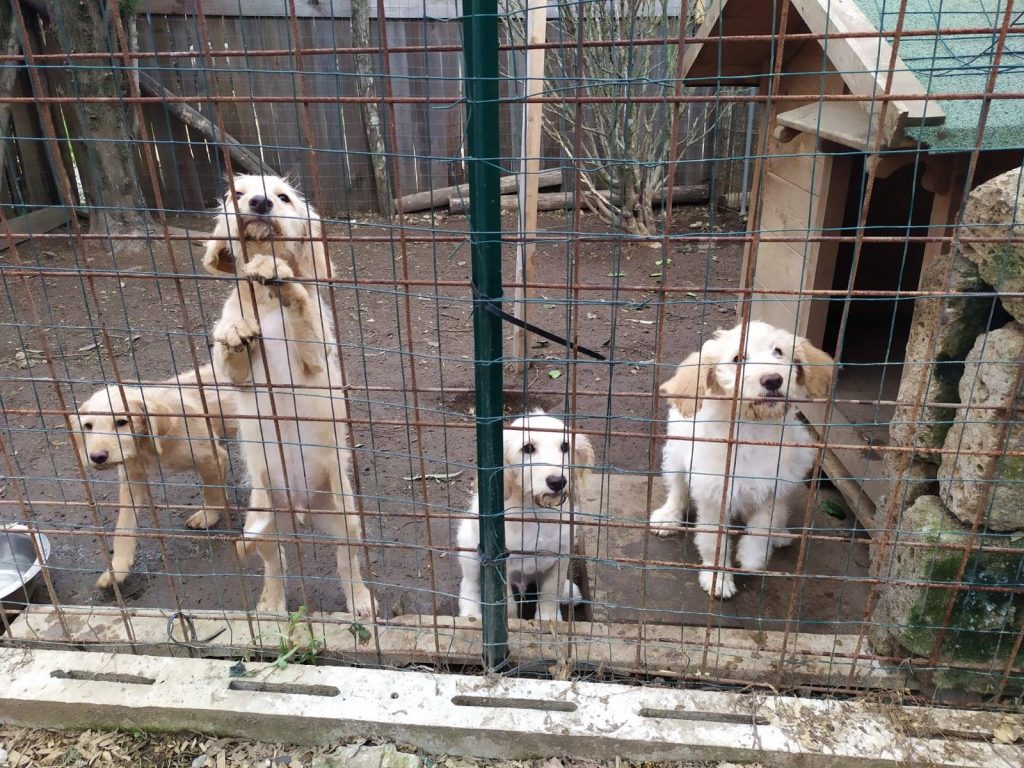
We must start from a great indicative assumption: in Italy, the suppression of animals kept in kennels is prohibited, except for health or character exceptions strictly monitored by the ASL.
This important starting point could be the beginning of a story with a happy ending in which the dramatic phenomenon can find its right epilogue and our country can give an extreme demonstration of civilization and progress.
Instead, as often happens in the Bel Paese, something went wrong, and not a little.
the phenomenon of stray dogs is therefore entirely entrusted to civilization, to the good functioning of the administrations and to the hard work of the third sector.
Unfortunately, the gap between areas with a high and low rate of stray dogs and the difference in the capillarization and efficiency of the authorities as well as the civic sense emerges.
In fact, we are all in some way accomplices until we do something.
LAV estimates for 2019 speak of 500-700 thousand stray dogs in Italy.
A population that is definitely too large for a nation that considers itself civilized.
Stray dogs are the result of abandonment or uncontrolled reproduction. In many Italian areas, packs of stray dogs are even considered a public safety problem. Furthermore, their presence is an indication of degradation and lack of assistance on the territory, and despite this dramatic image that we give to the world, nothing seems to affect the indifference of those who live with them except a few martyrs called volunteers.
Still for many, castration for males, or sterilization for females, is an act against nature and abandoning or mistreating is a question of culture.
if you can call it that.
Paradoxically, another term of comparison to evaluate the efficiency of administrations is the number of dogs taken in to kennels.
This is an important further step. In fact, it is an indication that the administrations are trying to intervene and by law (if all the health kennels respected it) the dog would have the advantage of being registered, of having veterinary assistance, of being sterilized and of having the possibility of finding its own family or of conquering a new one.
Here therefore the data, given that there are no, or almost no, stray dogs in northern Italy, indicate a very large cross-section. The stray dogs are a decidedly higher number than those on which the administrations intervene and the gap opens up even more if we analyze the number of adoptions or returns to owners in proportion to the income in the kennels.
And so that dramatic picture emerges that moves hundreds of small animal rights associations scattered throughout the territory that, like ants, desperately try to transmit culture, information, that raise awareness and that without any help from the administrations find themselves patching up where the State is absent.
Northern Italy, where the regions with a low rate of stray animals are concentrated, has almost eliminated the rate of stray animals, welcomes dogs in kennels where the application of the Law is guaranteed with health and re-educational interventions, where there is an owner he is traced and when this does not happen the associations, that do not have to worry and despair about the street phenomenon, can guarantee the well-being of the animals in kennels and shelters, as well as actively focus on their adoptions.
The same cannot be said elsewhere where stray dogs are the order of the day and the structures are not able to solve the problem on their own.
Let’s say that every citizen, even if they don’t have a vocation as a volunteer, would demonstrate a civic sense and cultural and evolutionary civilization if they sterilized their dog and avoided abandoning it when it is no longer needed.
If we started from this revolutionary assumption, it would be a concrete step forward towards solving the problem.
Of course, we must then consider the exceptions, which, as such, make the news and are brought to the forefront.
Discoveries of “lager kennels” or serial abusers in northern Italy and emptied kennels in the south. But, alas, they make the news and make a fuss precisely because they are exceptions.
In this context we find purebred dogs and those who want to have a dog with a Pedigree.
Even in this case, the issue must be addressed with extreme civility and culture.
Everyone, for the deepest reasons that fall within the most extreme freedom constitutionally guaranteed in our legal system, can decide to have a beautiful dog, and may not have the courage to assert their own parameter of beauty independently and prefers to rely on the standards set by others, in our case the ENCI.
They can decide to want a dog that is functional to their needs with a selection of the bloodline that has brought one aspect of behavioral and character propensity to predominate rather than another.
Or, no less important, they can make a conscious choice of breed and with a careful study discover that crosses on crosses of the same bloodlines have led to the development of some hereditary diseases that are the “Achilles heel” of their puppy and therefore want the guarantee that among the relatives of their loved one there are no “sick” people.
These speeches listed above all find a valid justification such as to lead to the purchase of a dog. We will not enter here into the volunteer speech of “love cannot be bought”, “for every dog you buy one remains in a cage”. if you come to the more or less romantic conclusion of wanting to buy the dog, it is an extreme gesture of civility, correctness, respect for the Laws and above all love for animals to ONLY AND EXCLUSIVELY turn to serious, recognized breeders, subjected to health checks. So it means that the dog costs. It costs a lot but it costs the right amount… after all, what value does a life have? The serious breeder respects the mother, lets her have only the right litters with respect for her life and sustainability. He only mates dogs free from the famous hereditary diseases and keeps the puppies with the mother for as long as necessary so that they learn and have the correct imprinting, guarantee the health and behavioral well-being of the family, entrust with great correctness, pay taxes and do not mistreat. The breeders issue the PEDIGREE.
Now, if you have come to read this cynical analysis, you are also ready to discover that the purebred dog bought at a low price is a MIXED if not taken from a recognized breeder with a regular pedigree. Furthermore, it is the result of mistreatment and pain of the parents and maybe even of the siblings, who very probably if not sold end up in kennels, who at the same time are sold to people of narrow-minded sensitivity and once again devoid of culture.
By buying a dog at a low price, and here it is the case to say it, you are not saving it because otherwise it would have ended up in the wrong hands. And it is precisely on this that the continuous increase of the market is based, which leads to the crisis of serious breeders, and to the decrease in the quality of standards of less serious breeders and to the increase of parasites of society who escape any health control, any authorization, any health guarantee!
YOU ARE INCREASING THE BLACK MARKET, YOU ARE INCREASING MALTREATMENT, YOU ARE FUNDING DISGUST.
And it is right that, in the era in which we live, given the profound lack of culture, someone says frankly what the truth is.
Buying a puppy that costs little, without the aforementioned guarantees to justify the cost, is the projection of the smallness of those who sell it and those who buy it. So if you are among those who feed this market you are worse criminals than those who abandon. Regardless of the self-induced justification of your conscience.
To close this dramatic picture, however, it must be said forcefully that adoptions are increasingly aware, that dog culture is taking an increasingly important foothold and that with disarming slowness there are silent warriors who do not stop carrying on this war because some Italian Regions have concretely demonstrated that the problem is solvable.
It is enough “just” to be civil. The hope is that civilization does not remain confined to some geographical areas and to some subjects scattered here and there, but that it spreads in every conscience: litters are made only if you are a breeder, all other puppies must be sterilized or prevented from reproducing. Always.
You do not mistreat or abandon, and if you want to do something more it is a gesture of love to help volunteers sterilize as many dogs as possible.
It is also worth highlighting a surprising network of solidarity that over the years has become a wonderful and formidable phenomenon, which has led to emptying some kennels in the south, or to solving and containing some situations of stray dogs. This is the network of volunteers that, beyond distances and possibilities, unites every day all the energies from south to north, from east to west, without stopping and that little by little is carrying forward a profound revolution that aims to impact culture and conscience.
And so, more and more often, volunteers from areas with a low stray rate, with half-empty kennels, take in strays from areas with a high rate to be able to empty the sea with a teaspoon, rewriting a story of unity and belonging opposed to that of the administrations.
Adopting has a much deeper value than simple welcoming.
It is a change of many destinies that intersect, it is a demonstration of culture and unity.
It is the awareness of being able to make a difference and of everyone being able to do it. The real difference, the one that starts from the bottom and that involves the soul. #insiemesipuo even if the numbers are scary.
Seven hundred thousand stray dogs in 2019. Seven hundred thousand. And the data is increasing.
Utdc fights to raise awareness of sterilization as a phenomenon of straying! watch our project the way to sterilization!
https://www.lav.it/cpanelav/js/ckeditor/kcfinder/upload/files/files/Dossier%20randagismo%202018.pdf http://www.salute.gov.it/portale/temi/p2_6.jsp?lingua=italiano&id=280&area=cani&menu=abandonment





